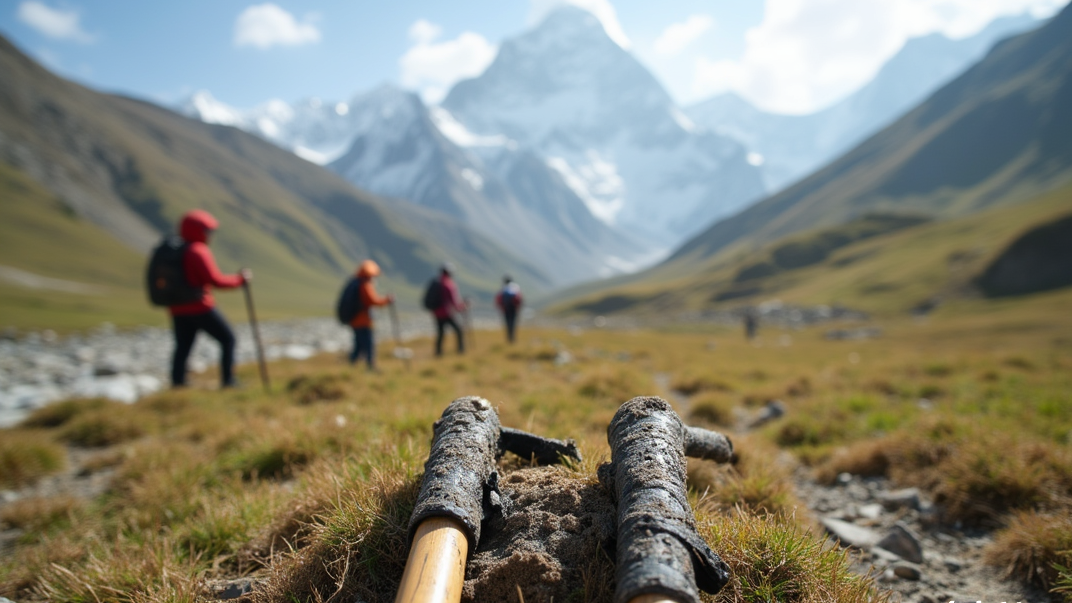At 4,000 meters on Mount Kinabalu, I witnessed something extraordinary: A Japanese trekker bowed deeply before strapping on her poles, treating them with the reverence of samurai swords. Meanwhile, an American thru-hiker nearby casually flipped his poles like drumsticks—yet both shared the same expectant grin. This is the paradox of trekking poles: simultaneously mundane and magical, practical and deeply personal.
1. The Physics of Four-Legged Hiking
Science Doesn’t Lie
- 33% reduction in knee impact force (Medicine & Science in Sports & Exercise study)
- 15-20% energy savings on ascents by engaging upper body (Cicerone Press data)
- 28% faster stream crossings with pole stabilization (New Zealand Mountain Safety Council)
The “Aha” Moment
“My first descent after ACL surgery—the poles caught me as my knee buckled. They weren’t just tools; they became extensions of my body.” – Rebecca, Colorado Trail thru-hiker
2. East vs. West: A Cultural Pole Dance
Asian Mountain Wisdom
- Bamboo Roots: Sherpas’ hand-carved poles double as tent frames and emergency splints
- Ritualistic Care: Japanese hikers often wrap grips in sacred shimenawa rope
- Social Signal: In South Korea, collapsible poles mark experienced hikers versus casual tourists
Western Performance Culture
- Tech Obsession: Carbon fiber vs. aluminum debates rival coffee snobbery
- Adjustable Everything: European brands push quick-lock mechanisms for alpine conditions
- Thru-Hiker Hacks: Appalachian Trail veterans use poles as tarp supports, bear bag tossers, and even splints
Cultural Crossroads
The Great Wall of China sees an amusing clash: European hikers with €300 poles gawk at local farmers effortlessly navigating the same steps with wooden staffs older than their grandparents.
3. The Poetry of Rhythm
Meditative Metronome
There’s a hidden cadence to pole use—the click-click-thud soundtrack of long trails:
- Japanese “Forest Bathing”: Deliberate pole plants sync with breathing
- Swiss Precision: Military-style marching rhythm on alpine passes
- Appalachian Blues: The lazy drag-and-tap of tired thru-hikers
Unexpected Benefits
- Pace Keeper: Maintains rhythm during whiteout navigation
- Stress Reliever: The repetitive motion eases trail anxiety
- Wildlife Alert: Regular tapping warns snakes in brushy areas
4. When Poles Become Personality
Confessions from the Trail
- “I name mine—left is ‘Simon’ and right is ‘Garfunkel.’ Don’t judge.” (Mark, PCT section hiker)
- “After 1,200km, my blisters formed perfect molds of the grips.” (Gina, Te Araroa)
- “Breaking a pole mid-hike feels like losing a limb.” (Norwegian mountain guide)
The Ultimate Test
During a sudden hailstorm in the Dolomites, I watched:
- Germans immediately converted poles into emergency tent anchors
- Chinese hikers linked poles to form a handrail for the group
- Americans… argued about weight savings versus durability
5. Choosing Your Trail Partner
Global Gear Guide
| Region | Preferred Pole Style | Cultural Quirk |
|---|---|---|
| Himalayas | Single bamboo staff | Blessed by monks |
| Alps | Foldable Z-poles | Color-coordinated to outfits |
| US Trails | Beat-up aluminum | Duct tape repairs as badges of honor |
| Japan | Collapsible titanium | Engraved with owner’s name |
Pro Tip
“Always test poles on stairs before buying. If they don’t feel like natural footsteps, keep searching.” – Yamauchi-san, Hokkaido guide
Trekking poles are the ultimate democratic gear—equally cherished by Nepalese porters carrying 50kg loads and Instagram hikers chasing fall foliage. They humble us with their simplicity yet reveal profound cultural truths: Europeans engineer them, Asians revere them, Americans abuse them, and the mountains quietly thank them all for treading lighter.






